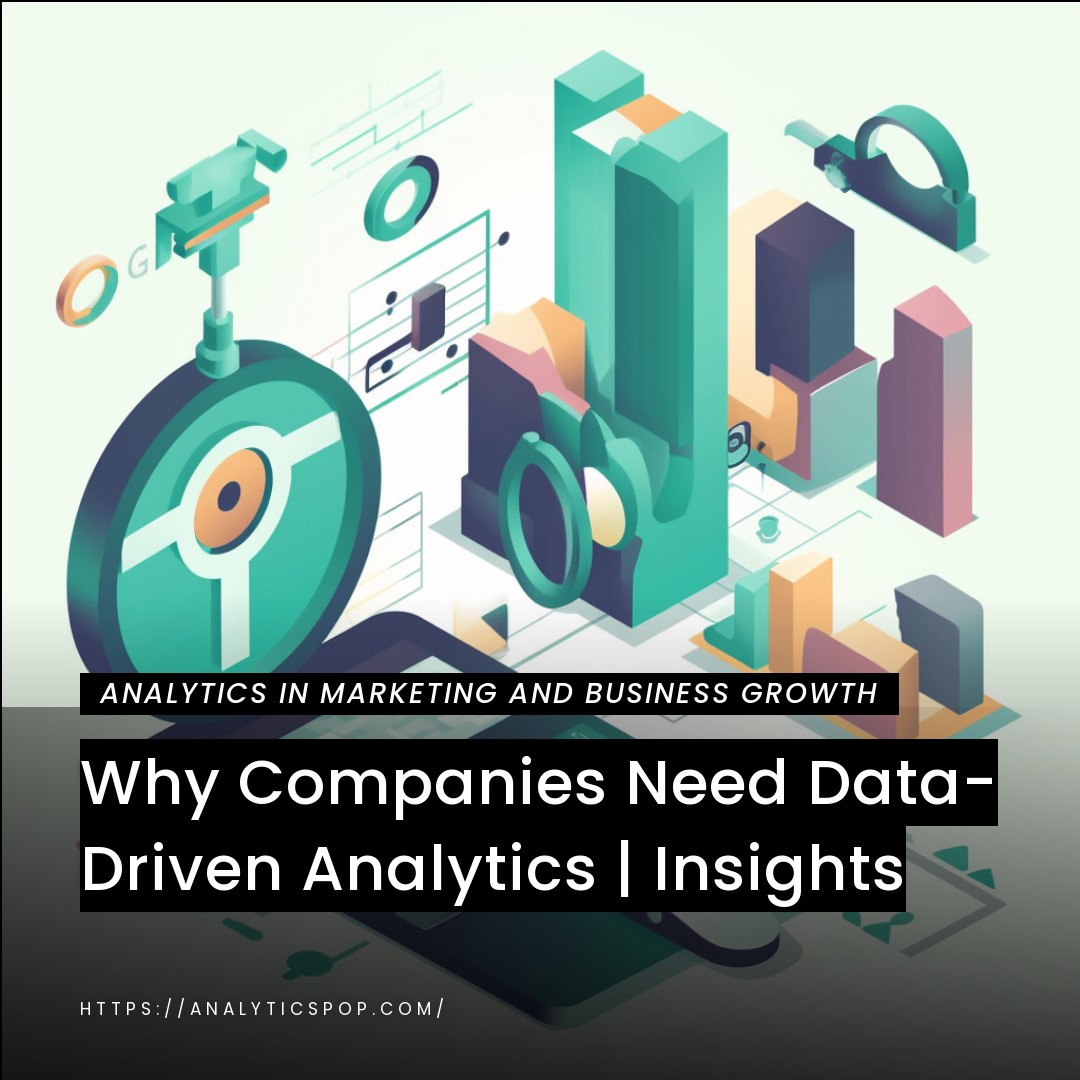Unleashing the Power of Data-Driven Analytics: Why Companies Need Insights for Success
In today’s fast-paced business landscape, companies must harness the power of data-driven analytics to succeed. Data-driven decision-making has become a crucial component of modern business strategies. Companies gain a competitive edge and drive growth by utilizing insights derived from extensive data analysis.
Statistics reveal the significance of data-driven analytics. According to a recent study, businesses that embrace data-driven decision-making are 5% more productive and 6% more profitable than their counterparts. These numbers underscore the tangible benefits of leveraging analytics for informed decision-making.
Let’s consider an example to illustrate the impact of data-driven insights. Imagine a retail company that analyzes customer purchasing patterns through data analytics. They can optimize inventory management, streamline supply chains, and deliver targeted marketing campaigns by identifying trends, such as popular products and peak shopping times. As a result, the company experiences higher sales, improved customer satisfaction, and increased profitability.
By incorporating data-driven analytics, businesses can uncover hidden patterns, detect emerging market trends, and make informed decisions with precision. It allows them to proactively adapt to changing consumer demands, optimize operations, and stay ahead of the competition.
Embracing data-driven analytics is no longer an option but is necessary for companies striving for success. By harnessing the power of insights derived from data analysis, businesses can drive growth, boost profitability, and gain a competitive advantage in today’s dynamic market landscape.
The Importance of Data-Driven Analytics
In today’s data-driven world, the importance of data-driven analytics cannot be overstated. Businesses increasingly rely on analytics to gain valuable insights and make informed decisions. Here’s why data-driven analytics is crucial for success:
- Enhanced Decision-making: Data-driven analytics provides businesses with a solid foundation for decision-making. Companies can uncover patterns, trends, and correlations that offer valuable insights by analyzing large volumes of structured and unstructured data. These insights enable leaders to make informed decisions backed by data, reducing the reliance on guesswork and intuition.
- Competitive Advantage: In a highly competitive market, gaining a competitive edge is paramount. Data-driven analytics equips businesses with the tools to understand their customers better, identify emerging market trends, and spot untapped opportunities. By leveraging these insights, companies can develop targeted strategies, personalize customer experiences, and stay one step ahead of the competition.
- Operational Efficiency: Data-driven analytics helps optimize business operations by identifying inefficiencies and areas for improvement. For example, analyzing supply chain data can highlight bottlenecks and streamline logistics, leading to cost savings and improved efficiency. By optimizing internal processes based on data-driven insights, companies can enhance productivity, reduce waste, and drive overall operational excellence.
- Customer Understanding: Understanding customers is vital for business success. Data-driven analytics allows companies to gather and analyze customer data, such as demographics, preferences, and behavior. This information enables businesses to segment their customer base, personalize marketing efforts, and deliver targeted products and services. By aligning offerings with customer needs, companies can enhance customer satisfaction, loyalty, and retention.
- Risk Mitigation: Data-driven analytics plays a crucial role in risk management. By analyzing historical data and applying predictive models, companies can identify potential risks and take proactive measures to mitigate them. Whether identifying fraud patterns, detecting cybersecurity threats, or assessing financial risks, data-driven analytics helps businesses safeguard their operations and assets.
Data-driven analytics is essential for businesses thriving in today’s data-driven world. By leveraging data insights, companies can make informed decisions, gain a competitive advantage, optimize operations, understand customers better, and mitigate risks. Investing in data-driven analytics is an investment in long-term success and growth.

Understanding the Value of Data-Driven Decision Making
The value of data-driven decision-making must be considered in today’s business landscape. By harnessing the power of data, businesses can make informed decisions that lead to improved outcomes and increased success. Here’s a closer look at the key benefits and value of data-driven decision-making:
- Accuracy and Precision: Data-driven decision-making relies on concrete data and facts rather than assumptions or intuition. Businesses can gain accurate and precise insights into their operations, market trends, customer behavior, and more by analyzing large datasets. This enables leaders to make decisions based on solid evidence, reducing the risk of errors or biases.
- Cost Efficiency: Data-driven decision-making helps businesses optimize their resources and improve cost efficiency. By analyzing data, companies can identify areas where costs can be reduced, processes can be streamlined, and operational inefficiencies can be addressed. For example, analyzing production data can uncover opportunities to minimize waste or optimize supply chain management, resulting in significant cost savings.
- Improved Strategic Planning: Data-driven decision-making empowers businesses to develop robust and effective strategic plans. Companies can identify growth opportunities, assess market demand, and anticipate industry changes by analyzing historical data and market trends. These insights enable organizations to align their strategies with market realities and make proactive decisions that drive long-term success.
- Enhanced Customer Insights: Customer-centricity is essential in today’s competitive landscape, and data-driven decision-making is a powerful tool for understanding customer behavior and preferences. Businesses can identify patterns, trends, and buying habits by analyzing customer data, enabling them to personalize marketing efforts, improve customer experiences, and develop targeted products or services. This leads to higher customer satisfaction, loyalty, and revenue.
- Competitive Advantage: Data-driven decision-making provides a competitive advantage by enabling businesses to stay ahead of the curve. By leveraging data analytics, companies can uncover market trends, identify emerging opportunities, and spot potential risks. This allows them to make proactive decisions and adapt their strategies to gain a competitive edge in the market.
- Continuous Improvement: Data-driven decision-making promotes a culture of continuous improvement within organizations. By regularly analyzing data, businesses can monitor their performance, identify areas for improvement, and measure the effectiveness of implemented strategies. This iterative process enables companies to make data-backed adjustments and optimizations, driving ongoing growth and success.
The value of data-driven decision-making lies in its ability to provide accurate insights, improve cost efficiency, inform strategic planning, enhance customer understanding, foster a competitive advantage, and drive continuous improvement. By embracing data-driven decision-making, businesses can make more informed, effective decisions that propel them toward success in an increasingly data-centric world.
The Competitive Edge of Data-Driven Companies
In today’s competitive business landscape, data-driven companies have a distinct advantage over their counterparts. These companies gain a competitive edge in several key areas by leveraging data to inform decision-making. Here’s a closer look at the competitive advantages of data-driven companies:
- Insights for Informed Decision-Making: Data-driven companies can access vast amounts of data from various sources, including customer interactions, market trends, and operational metrics. Analyzing this data allows them to gain deep insights into customer behavior, preferences, and market dynamics. These insights inform strategic decision-making, enabling companies to make well-informed choices that align with customer needs and market opportunities.
- Personalized Customer Experiences: Data-driven companies understand that customer personalization is crucial for success. By leveraging customer data, such as purchase history, browsing behavior, and demographic information, these companies can create tailored experiences. From targeted marketing campaigns to customized product recommendations, personalized customer experiences drive higher customer satisfaction, loyalty, and a competitive advantage in the market.
- Agile and Adaptive Strategies: Data-driven companies can quickly adapt to changing market conditions. By continuously monitoring and analyzing data, they can identify emerging trends, shifts in consumer preferences, and new market opportunities. This enables them to pivot their strategies, optimize operations, and stay ahead of the competition. The ability to make data-backed decisions promptly gives data-driven companies the agility to respond effectively to market dynamics.
- Operational Efficiency and Cost Savings: Data-driven companies leverage data analytics to optimize their internal operations. They can identify inefficiencies and streamline workflows by analyzing operational data, such as production processes, supply chain logistics, and resource allocation. This results in improved operational efficiency, reduced costs, and increased profitability. Data-driven insights also enable predictive maintenance, minimizing downtime and maximizing productivity.
- Data-Enabled Innovation: Data-driven companies harness the power of data to fuel innovation and drive product development. They can identify unmet needs and create innovative solutions by analyzing customer feedback, market trends, and emerging technologies. Data-driven insights also enable rapid prototyping, testing, and iteration, ensuring that companies bring market-leading products and services to market.
- Risk Mitigation and Fraud Detection: Data-driven companies have an advantage in identifying and mitigating risks. By analyzing data patterns and implementing predictive models, they can detect potential fraud, cybersecurity threats, and other risks to their business. This proactive approach to risk management helps safeguard the company’s assets, reputation, and customer trust.
Data-driven companies possess a competitive edge through informed decision-making, personalized customer experiences, agility, operational efficiency, innovation, and risk mitigation. By embracing data as a strategic asset, these companies can position themselves as market leaders, drive growth, and outperform their competitors in today’s data-centric business environment.

Gaining Actionable Insights through Data-Driven Analytics
Data-driven analytics allows businesses to gain actionable insights that drive informed decision-making and spur growth. By analyzing vast amounts of data, companies can uncover valuable information that translates into tangible actions. Here’s a closer look at how data-driven analytics enables businesses to gain actionable insights:
- Identifying Patterns and Trends: Through data analysis, businesses can identify patterns and trends that are otherwise not readily apparent. Whether it’s customer behavior, market dynamics, or operational performance, data-driven analytics allows companies to detect patterns and trends that provide valuable insights. For example, analyzing customer purchasing data may reveal seasonal buying patterns or emerging trends in product preferences, enabling businesses to adjust their strategies and offerings accordingly.
- Improving Operational Efficiency: Data-driven analytics enables companies to optimize operations and drive efficiency. By analyzing operational data, such as production processes, supply chain logistics, or resource allocation, businesses can identify bottlenecks, inefficiencies, and areas for improvement. These insights enable targeted actions to streamline operations, reduce costs, and enhance productivity.
- Enhancing Customer Understanding: Understanding customers is critical for business success, and data-driven analytics offers many customer insights. Businesses can better understand customer preferences, needs, and behavior by analyzing customer data. This information empowers companies to personalize marketing campaigns, tailor product offerings, and improve customer experiences. Actionable insights from data-driven analytics allow businesses to engage customers meaningfully, increasing satisfaction and loyalty.
- Optimizing Marketing Strategies: Data-driven analytics enables businesses to maximize their marketing efforts. Companies can target their marketing messages more effectively by analyzing customer demographics, behavior, and campaign response. Actionable insights derived from data analytics can guide content creation, channel selection, and campaign optimization decisions. This data-driven approach ensures that marketing resources are allocated efficiently, leading to better customer engagement and higher conversion rates.
- Predictive Analytics for Future Planning: Data-driven analytics allows businesses to employ predictive models and forecasting techniques. Companies can make informed predictions about future scenarios by analyzing historical data, market trends, and external factors. These actionable insights enable proactive planning, risk mitigation, and strategic decision-making to capitalize on opportunities or mitigate potential challenges.
- Real-time Monitoring and Decision-Making: Data-driven analytics provides businesses with real-time monitoring capabilities. By leveraging real-time data streams and dashboards, companies can monitor key performance indicators, market trends, or customer sentiment in real time. This empowers businesses to make agile decisions and take immediate action when required, ensuring timely responses to market changes and emerging opportunities.
Data-driven analytics equips businesses with actionable insights that drive informed decision-making. By identifying patterns, optimizing operations, enhancing customer understanding, optimizing marketing strategies, employing predictive analytics, and enabling real-time monitoring, companies can take proactive actions that lead to growth, efficiency, and a competitive advantage in their respective industries.
Uncovering Hidden Patterns and Trends
Uncovering hidden patterns and trends is a crucial benefit of data-driven analytics. By delving into large datasets, businesses can reveal valuable insights that need to be made apparent. Here’s a closer look at how data-driven analytics helps uncover hidden patterns and trends:
- Data Exploration and Visualization: Data-driven analytics allows businesses to explore and visualize their data meaningfully. Through interactive dashboards, charts, and graphs, companies can identify patterns, correlations, and trends that might not be evident in raw data. Visual representations make uncovering hidden relationships and gaining a holistic understanding of the data more accessible.
- Machine Learning and AI Algorithms: Advanced machine learning and AI algorithms are instrumental in uncovering hidden patterns and trends. These algorithms can process vast amounts of data, identify complex ways, and make predictions. By applying these techniques to the data, businesses can discover valuable insights that lead to actionable outcomes.
- Anomaly Detection: Data-driven analytics helps identify anomalies or outliers in the data. Anomalies can represent hidden patterns or trends that deviate from the norm. By detecting these anomalies, businesses can further investigate the underlying causes and leverage the insights for decision-making. For example, identifying sudden spikes or drops in sales could indicate emerging market trends or issues that require attention.
- Association and Sequence Analysis: Data-driven analytics enables association and sequence analysis, which helps identify hidden relationships between variables or events. Association analysis uncovers co-occurrence patterns, revealing items or events that tend to happen together. Sequence analysis finds patterns in sequential data, such as customer behavior or user journeys. These techniques illuminate hidden trends and dependencies, guiding business strategies and process optimizations.
- Text and Sentiment Analysis: Text and sentiment analysis techniques allow businesses to extract insights from unstructured data sources such as customer reviews, social media posts, or survey responses. Businesses can uncover hidden patterns and emerging themes that inform decision-making and drive customer-focused strategies by analyzing text data’s sentiment, topics, and trends.
- Time-Series Analysis: Time-series analysis is a powerful tool for uncovering hidden patterns and trends in temporal data. By analyzing data over time, businesses can identify recurring patterns, seasonal trends, or long-term patterns that might not be immediately noticeable. This analysis helps predict future trends and make informed decisions based on historical patterns.
By leveraging data-driven analytics techniques such as visualization, machine learning, anomaly detection, association analysis, sentiment analysis, and time-series analysis, businesses can uncover hidden patterns and trends within their data. These insights enable proactive decision-making, improved strategies, and a competitive advantage in the marketplace.

Driving Innovation and Identifying Opportunities
Data-driven analytics plays a pivotal role in driving innovation and identifying business opportunities. By harnessing the power of data, companies can gain valuable insights that spark creativity, foster innovation, and uncover untapped potential. Here’s how data-driven analytics helps in driving innovation and identifying opportunities:
- Market Research and Trend Analysis: Data-driven analytics allows businesses to conduct comprehensive market research and trend analysis. Companies can identify emerging trends, changing customer preferences, and market gaps by analyzing market data, consumer behavior, and competitor insights. These insights serve as a foundation for innovation, guiding the development of new products, services, or business models that address evolving market needs.
- Customer Insights and Feedback: Data-driven analytics enables businesses to gain deep customer insights and feedback. Companies can understand customer preferences, pain points, and expectations by analyzing customer data, such as purchase history, feedback surveys, or social media interactions. This information fuels innovation by helping businesses identify areas for improvement, develop customer-centric solutions, and create personalized experiences that meet customer demands.
- Predictive Analytics and Forecasting: Data-driven analytics empowers businesses to leverage predictive analytics and forecasting models. Companies can accurately predict future scenarios by analyzing historical data, market trends, and external factors. This enables proactive planning, identifying opportunities, and anticipating challenges. By leveraging predictive insights, businesses can make strategic decisions that drive innovation, seize opportunities, and stay ahead of the competition.
- Data-driven Ideation and Experimentation: Data-driven analytics encourages a culture of creativity and experimentation within organizations. Businesses can identify patterns, correlations, and anomalies that spark innovative ideas by exploring and analyzing data. These ideas can be tested through controlled experiments or pilot projects, leveraging data insights to measure success and refine strategies. Data-driven ideation and experimentation foster a culture of innovation, allowing businesses to iterate and improve continuously.
- Competitive Intelligence: Data-driven analytics helps businesses gather competitive intelligence and identify opportunities in the market. Companies can gain insights into their competitive landscape by analyzing data on competitor performance, market share, pricing strategies, or customer reviews. These insights enable businesses to identify gaps, differentiate themselves, and uncover niche opportunities that competitors might have overlooked.
- Collaboration and Open Data Initiatives: Data-driven analytics promotes collaboration and open data initiatives. By sharing and analyzing data across organizations, industries, or sectors, businesses can uncover synergies, identify shared challenges, and drive innovation collectively. Open data initiatives also encourage the development of new products, services, or solutions that leverage shared data resources, fostering innovation on a broader scale.
Data-driven analytics empowers businesses to drive innovation and identify opportunities. By leveraging market research, customer insights, predictive analytics, creativity, competitive intelligence, and collaboration, companies can unlock untapped potential, develop innovative solutions, and stay ahead in a rapidly evolving business landscape. Data-driven innovation is a crucial driver of growth, competitiveness, and long-term success.
Implementing Data-Driven Analytics Strategies
Implementing data-driven analytics strategies is essential for businesses to unlock the full potential of their data and gain valuable insights. Here are vital steps to successfully implement data-driven analytics strategies:
- Define Clear Objectives: Start by clearly defining your objectives and goals. Determine the specific business challenges you aim to address or opportunities you want to leverage through data-driven analytics. For example, improving customer retention, optimizing supply chain efficiency, or enhancing marketing campaigns. Setting clear objectives will guide your analytics efforts and help measure success.
- Data Collection and Integration: Establish robust data collection processes and ensure the availability of quality data. Identify relevant data sources internally (e.g., CRM systems, transactional databases) and externally (e.g., market research, social media data). Integrate and consolidate data from various sources to create a unified view, enabling comprehensive analysis.
- Select Appropriate Analytics Tools and Technologies: Choose the right analytics tools and technologies that align with your objectives and data requirements. This may include data visualization platforms, statistical analysis software, machine learning algorithms, or cloud-based analytics solutions. Assess the tools’ scalability, flexibility, and compatibility to meet your evolving needs.
- Build a Skilled Data Analytics Team: Assemble a skilled team with the expertise of data analytics, statistics, and domain knowledge. Data scientists, analysts, and business intelligence professionals can help interpret data, conduct advanced analytics, and generate actionable insights. Encourage collaboration between data experts and business stakeholders to align analytics with business goals.
- Data Exploration and Analysis: Perform exploratory data analysis to deeply understand the data and identify patterns, trends, and anomalies. Apply statistical techniques, data mining algorithms, and visualization tools to uncover meaningful insights. Conduct hypothesis testing and experiment with different models to validate findings and refine strategies.
- Communicate and Visualize Insights: Transform complex data into clear and actionable insights that stakeholders can easily understand. Utilize data visualization techniques to present findings in visually compelling formats, such as charts, graphs, or dashboards. Effective communication of insights is crucial for driving organizational buy-in and facilitating data-driven decision-making.
- Implement Actionable Strategies: Translate insights into actionable strategies and initiatives. Collaborate with relevant departments to implement changes based on the analytics findings. Continuously monitor the impact of implemented systems and iterate as needed. Align analytics-driven actions with organizational goals to drive measurable business outcomes.
- Foster a Data-Driven Culture: Instill a data-driven culture within the organization by promoting data literacy, encouraging data-driven decision-making, and recognizing the value of analytics across all levels. Provide training and resources to empower employees to leverage data and insights in their day-to-day work effectively.
- Regularly Evaluate and Refine: Continuously assess the effectiveness of data-driven analytics strategies and adjust them as needed. Monitor key performance indicators and metrics to evaluate the impact of analytics initiatives on business outcomes. Solicit stakeholder feedback and incorporate learnings to refine and optimize your data-driven analytics approach.
By following these steps, businesses can successfully implement data-driven analytics strategies and unlock the power of data to drive informed decision-making, gain competitive advantages, and achieve strategic goals.

Data Collection and Integration
Data collection and integration are crucial steps in implementing data-driven analytics strategies. Properly collecting and integrating data from various sources is essential to ensure the availability of accurate, relevant, and comprehensive data for analysis. Here are key considerations for data collection and integration:
- Identify Data Sources: Identify the relevant data sources that align with your objectives. This may include internal sources such as transactional databases, customer relationship management (CRM) systems, sales records, or operational systems. External sources such as market research reports, social media data, or public datasets can also provide valuable insights. Determine the data sources that contain the necessary information to address your analytics goals.
- Ensure Data Quality: Data quality is critical for practical analysis. Establish data quality checks and validation processes to ensure the collected data’s accuracy, completeness, consistency, and reliability. Implement data cleansing techniques to address any inconsistencies, errors, or duplicates. Data quality efforts should focus on data collection methods, validation rules, and ongoing data maintenance practices.
- Data Integration: Data integration combines data from various sources into a unified view or warehouse. Select an appropriate data integration approach based on the complexity of your data sources and requirements. This can involve extraction, transformation, and loading (ETL) processes, where data is extracted from source systems, transformed to fit the target structure, and loaded into a central repository. Alternatively, you can opt for data virtualization or data federation techniques to access and integrate data without physically moving or replicating it.
- Data Governance and Security: Establish robust policies and procedures to ensure data security, privacy, and compliance with relevant regulations. Define access controls, data usage policies, and data retention guidelines to protect sensitive information. Implement data encryption, user authentication, and secure data transmission protocols to safeguard data during collection and integration processes.
- Data Mapping and Standardization: Standardize data elements and formats to ensure consistency across different data sources. Develop data mapping strategies to align data fields from diverse sources and establish standard definitions. This helps ensure accurate data integration and meaningful analysis across the organization. Create data dictionaries or metadata catalogs to document the meaning and context of each data element, facilitating understanding and collaboration.
- Data Transformation and Enrichment: Transform and enrich the collected data to make it more suitable for analysis. This may involve data cleansing, normalization, aggregation, or creating derived variables. Apply data transformation techniques to enhance data quality, eliminate redundancies, and consolidate related information. Data enrichment through external sources or third-party data providers can supplement existing data with additional attributes or insights.
- Data Scalability and Automation: Consider the scalability of your data collection and integration processes. As data volumes grow, ensure your systems can handle increased data loads and scale accordingly. Automate data collection and integration processes to improve efficiency and reduce manual effort. This can involve utilizing data integration tools, scheduling regular data imports, and leveraging application programming interfaces (APIs) for seamless data exchange.
By following these considerations, businesses can effectively collect and integrate data, ensuring a solid foundation for data-driven analytics. Robust data collection and integration practices lead to accurate, comprehensive data sets that drive meaningful insights and support informed decision-making.
Building Analytical Capabilities and Culture
Building analytical capabilities and fostering a data-driven culture is crucial to implementing successful data-driven analytics strategies. Here are vital considerations to develop analytical abilities and promote a data-driven culture within an organization:
- Establish a Data and Analytics Strategy: Define a precise data and analytics strategy that aligns with the organization’s goals and objectives. Identify the critical business areas where analytics can provide the most value and prioritize accordingly. Outline the desired outcomes, resource requirements, and timelines for implementing analytics initiatives.
- Invest in Talent and Skills: Build a team of skilled professionals with data analytics, statistics, and data visualization expertise. Hire data scientists, analysts, and engineers who can effectively analyze and interpret data. Invest in training and upskilling programs to enhance the analytical capabilities of existing employees. Foster a culture of continuous learning and professional development in analytics.
- Enable Access to Data and Tools: Provide employees with easy access to relevant data and analytics tools. Establish a centralized data repository or warehouse that houses up-to-date, clean, integrated data. Implement user-friendly analytics tools and platforms that enable self-service analytics for non-technical users. Empower employees to explore and analyze data to uncover insights and make data-driven decisions.
- Promote Collaboration and Cross-Functional Engagement: Encourage collaboration and cross-functional engagement between business units and the analytics team. Foster a culture of collaboration where business stakeholders and analysts work together to define analytics requirements, validate findings, and drive decision-making. Promote knowledge-sharing sessions, workshops, and forums to facilitate cross-functional collaboration.
- Communicate and Visualize Insights Effectively: Develop effective data visualization techniques to communicate insights clearly and understandably. Use charts, graphs, and dashboards to present data-driven insights visually. Tailor the communication of insights to different audiences, ensuring that information is accessible and actionable. Encourage storytelling with data to create compelling narratives that resonate with stakeholders.
- Encourage Experimentation and Iteration: Foster a culture of experimentation and iteration. Encourage employees to explore new ideas, test hypotheses, and learn from data-driven experiments. Create a safe environment where failures are seen as learning opportunities. Emphasize the importance of data-driven decision-making and encourage employees to back their proposals with data and evidence.
- Recognize and Reward Data-Driven Successes: Recognize and reward individuals and teams demonstrating successful data-driven initiatives. Celebrate achievements, highlight success stories, and communicate the positive impact of data-driven decision-making throughout the organization. Encouraging and acknowledging data-driven successes reinforces the importance of analytics and fosters a data-driven culture.
- Continuously Monitor and Evaluate: Regularly monitor and evaluate the effectiveness of analytics initiatives. Measure key performance indicators (KPIs) and track the impact of data-driven decisions on business outcomes. Solicit feedback from stakeholders to gather insights and identify areas for improvement. Use these insights to refine analytical capabilities and drive continuous improvement.
Organizations can build robust analytical capabilities and cultivate a data-driven culture by focusing on these considerations. This enables data-driven decision-making, fosters innovation, and unlocks the full potential of data to drive business success.
FAQ's

Why is data-driven analytics important for companies?
Data-driven analytics is of paramount importance for companies due to several compelling reasons:
- Informed Decision-Making: Data-driven analytics allows companies to make informed decisions based on objective evidence rather than relying solely on intuition or gut feelings. Companies gain insights that guide strategic choices, operational optimizations, and resource allocation by analyzing vast amounts of data. Informed decision-making reduces risks, increases the likelihood of positive outcomes, and improves overall business performance.
- Competitive Advantage: Companies that leverage data-driven analytics gain a significant competitive advantage in today’s competitive business landscape. By analyzing market trends, customer behavior, and competitor strategies, companies can identify untapped opportunities, anticipate shifts in the market, and develop tailored strategies to stay ahead. Data-driven insights enable companies to differentiate themselves, enhance customer experiences, and outperform competitors.
- Enhanced Operational Efficiency: Data-driven analytics enables companies to optimize their operations and improve efficiency. Companies can identify bottlenecks, streamline processes, and eliminate waste by analyzing operational data. This leads to cost savings, increased productivity, and improved resource allocation. Operational efficiency gained through data-driven insights allows companies to optimize their supply chains, enhance production processes, and improve overall performance.
- Customer Understanding and Personalization: Understanding customers is critical for business success, and data-driven analytics helps companies gain deep insights into customer preferences, behavior, and needs. Companies can segment their customer base by analyzing customer data, personalize marketing campaigns, and tailor products or services to specific customer segments. This customer-centric approach enhances customer satisfaction, loyalty, and retention, ultimately driving revenue growth.
- Risk Management and Fraud Detection: Data-driven analytics enables companies to manage risks and detect potential fraud proactively. By analyzing patterns and anomalies in data, companies can identify potential risks, anticipate threats, and implement mitigation strategies. This helps safeguard the company’s assets, reputation, and financial stability. Data-driven analytics can also aid in fraud detection by identifying irregular patterns and suspicious activities, enabling timely intervention and prevention.
- Innovation and Business Growth: Data-driven analytics fuels innovation by providing insights into emerging trends, customer needs, and market gaps. By analyzing data, companies can identify new product or service opportunities, optimize existing offerings, and drive innovation within their industries. Data-driven insights foster creativity, enable evidence-based decision-making, and fuel business growth by capitalizing on market dynamics.
- Measurable Performance Evaluation: Data-driven analytics allows companies to objectively measure and evaluate their performance. By setting key performance indicators (KPIs) and tracking relevant metrics, companies can assess their progress, identify areas for improvement, and measure the impact of implemented strategies. This data-driven approach to performance evaluation facilitates continuous improvement and helps companies stay on track toward their goals.
In summary, data-driven analytics is essential for companies as it enables informed decision-making, provides a competitive advantage, enhances operational efficiency, improves customer understanding and personalization, aids in risk management, fosters innovation, and allows measurable performance evaluation. By leveraging data and analytics, companies can unlock insights that drive growth, efficiency, and long-term success in today’s data-centric business landscape.



